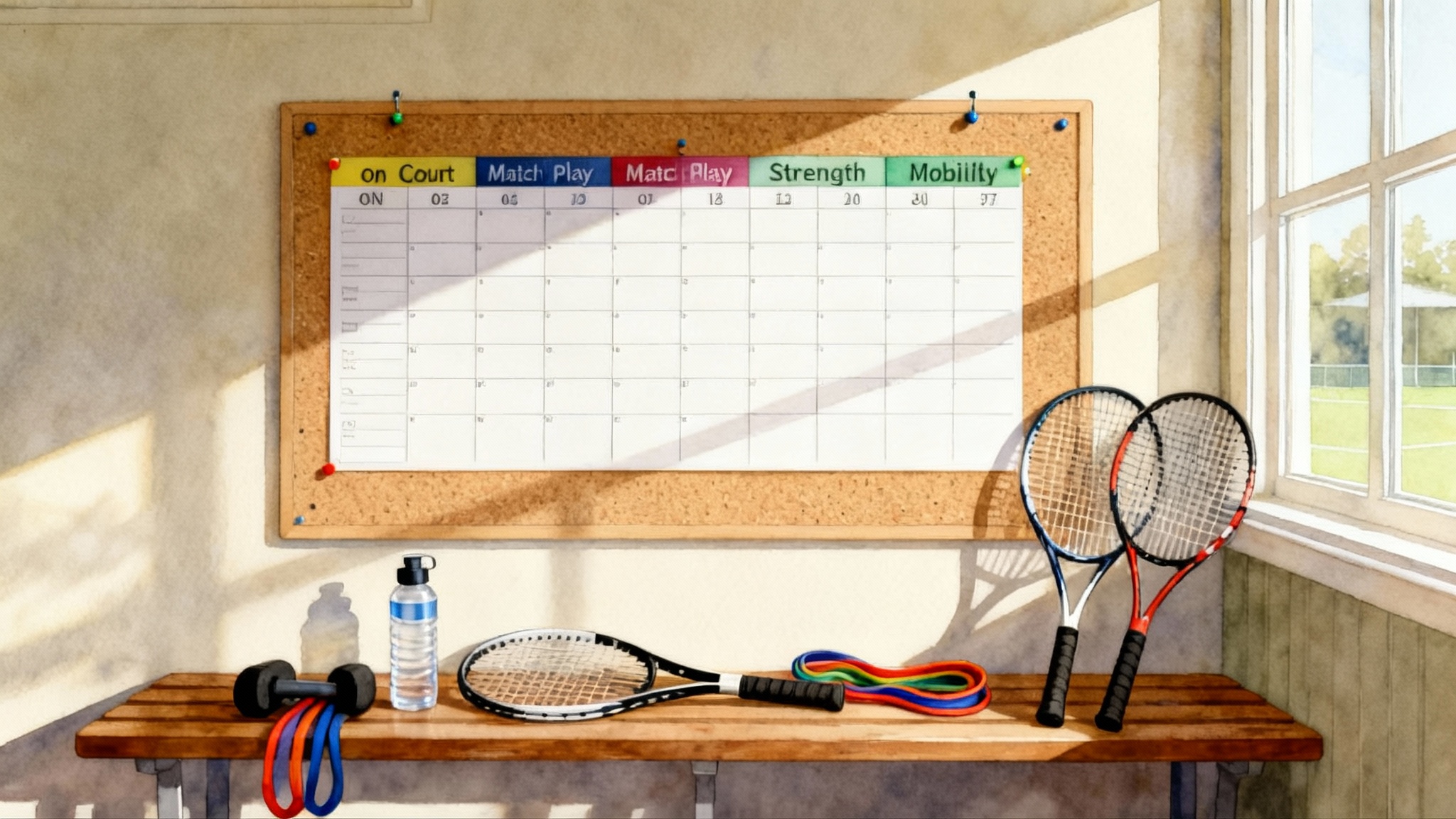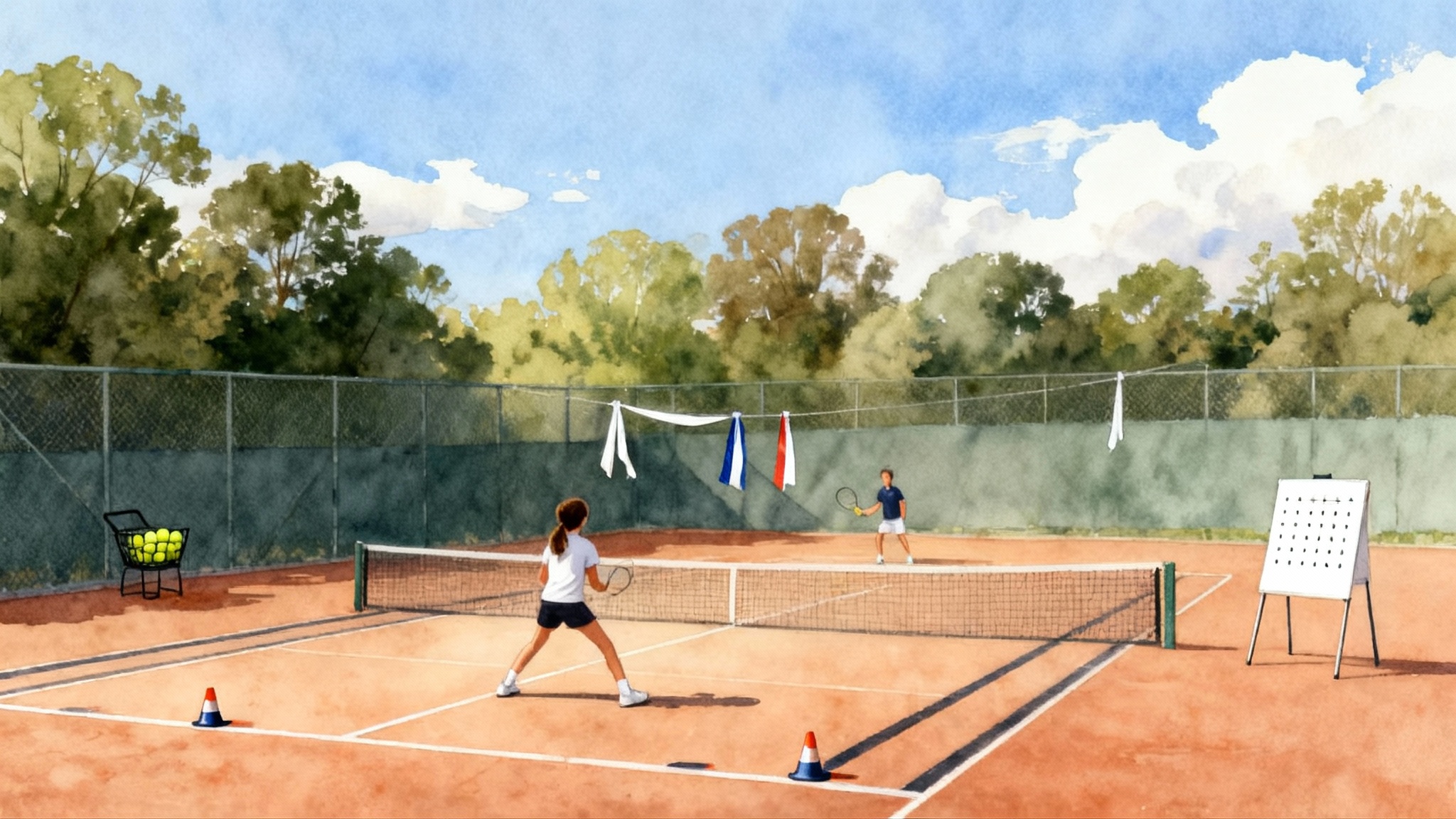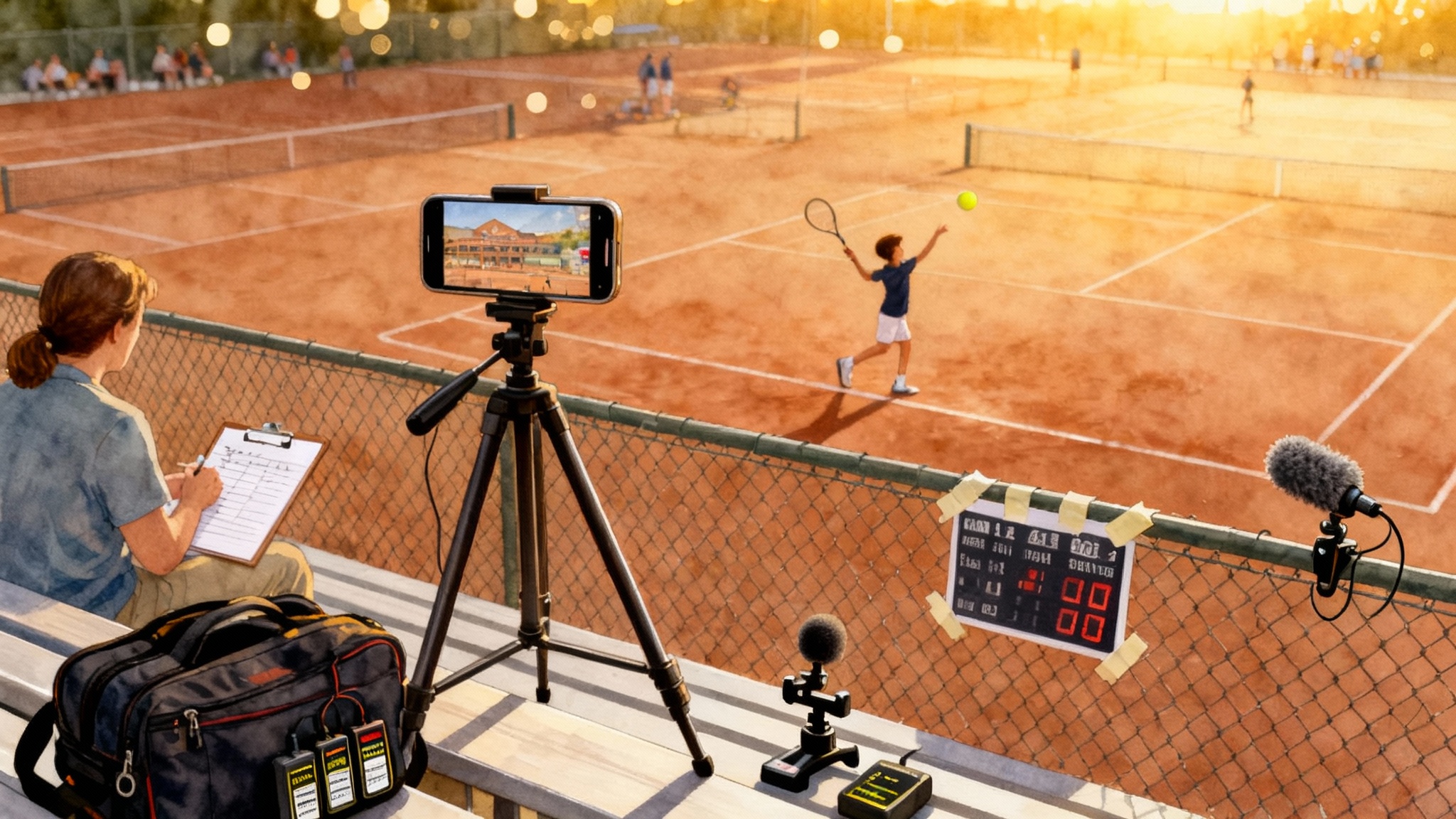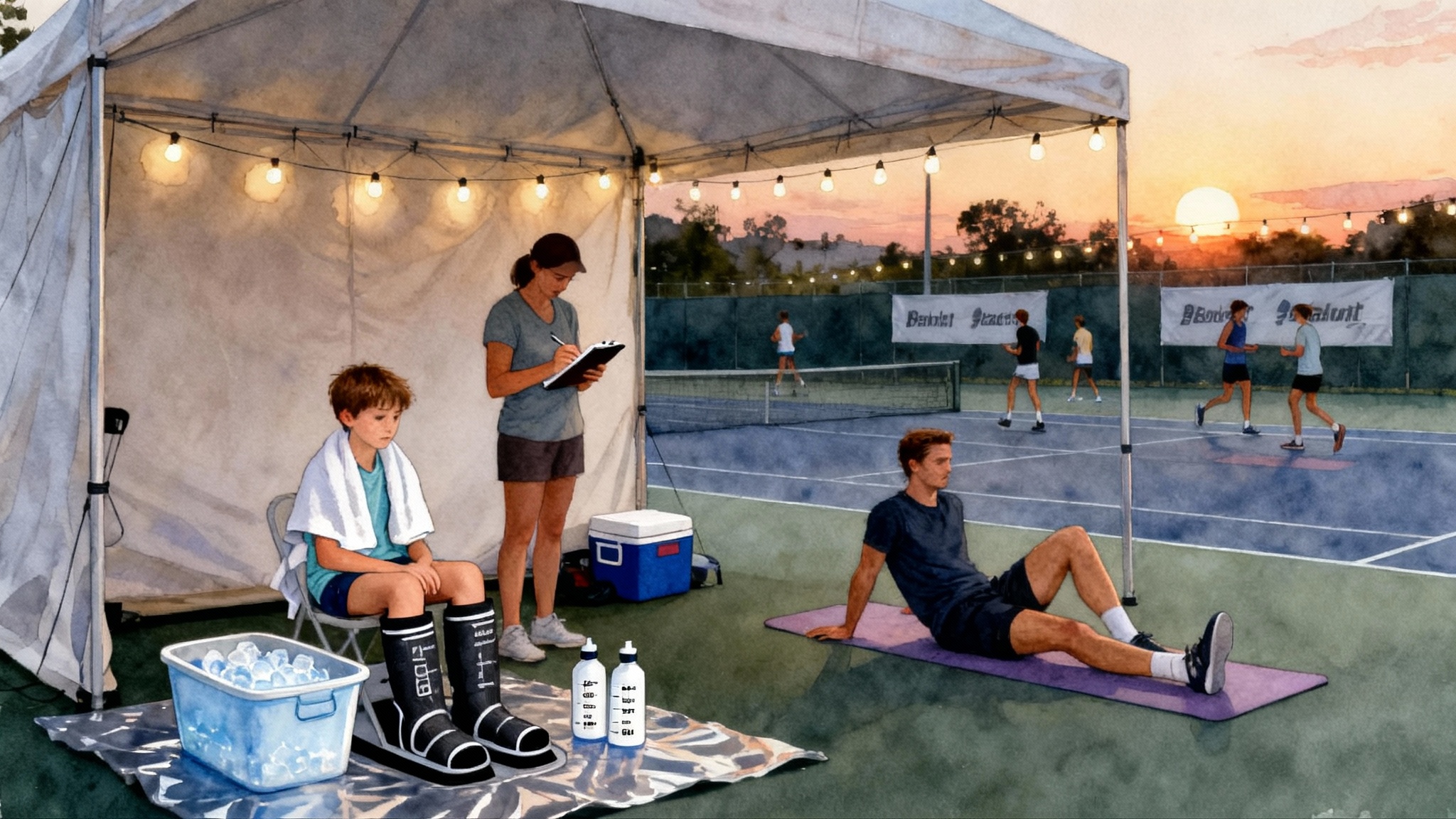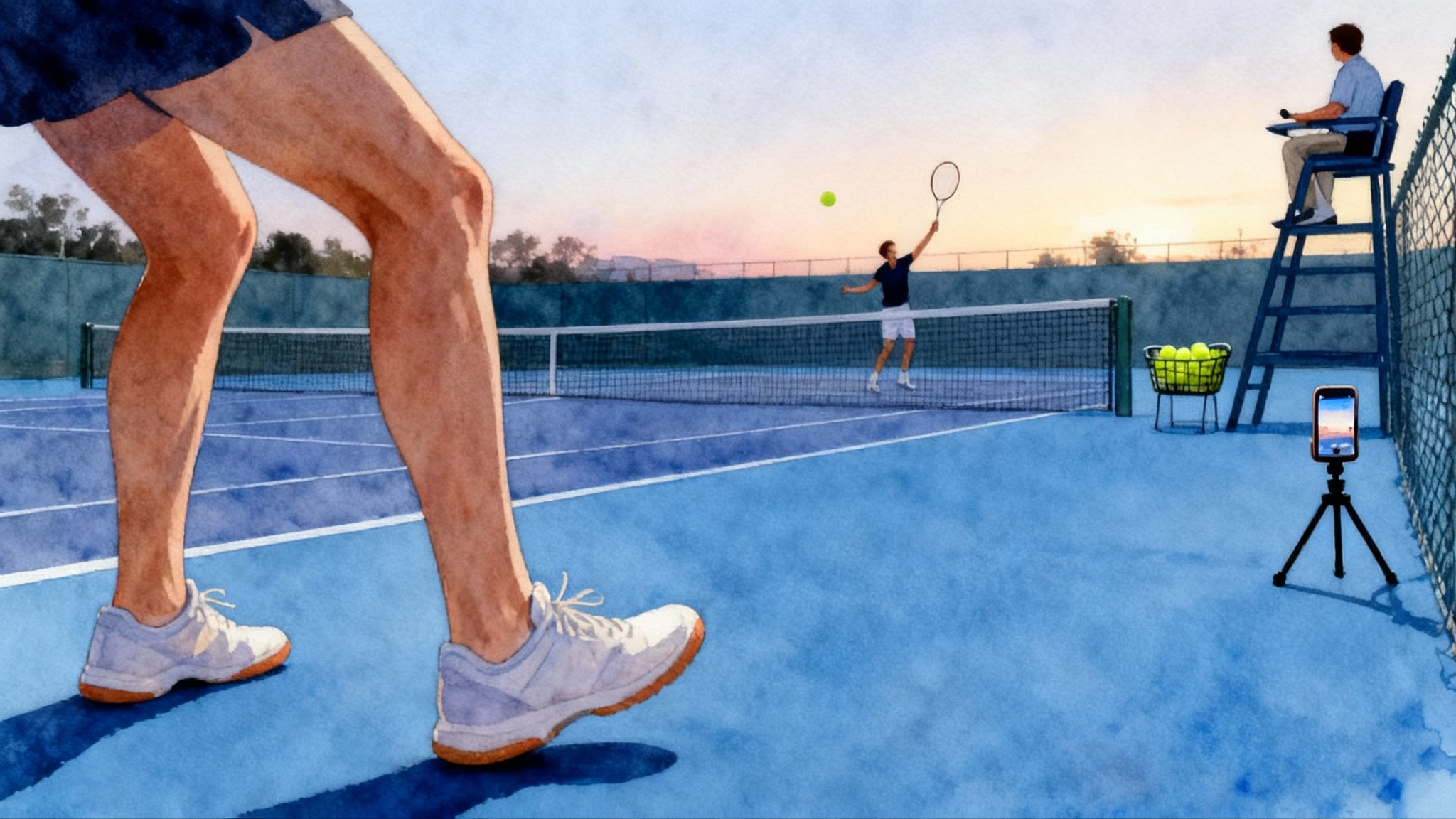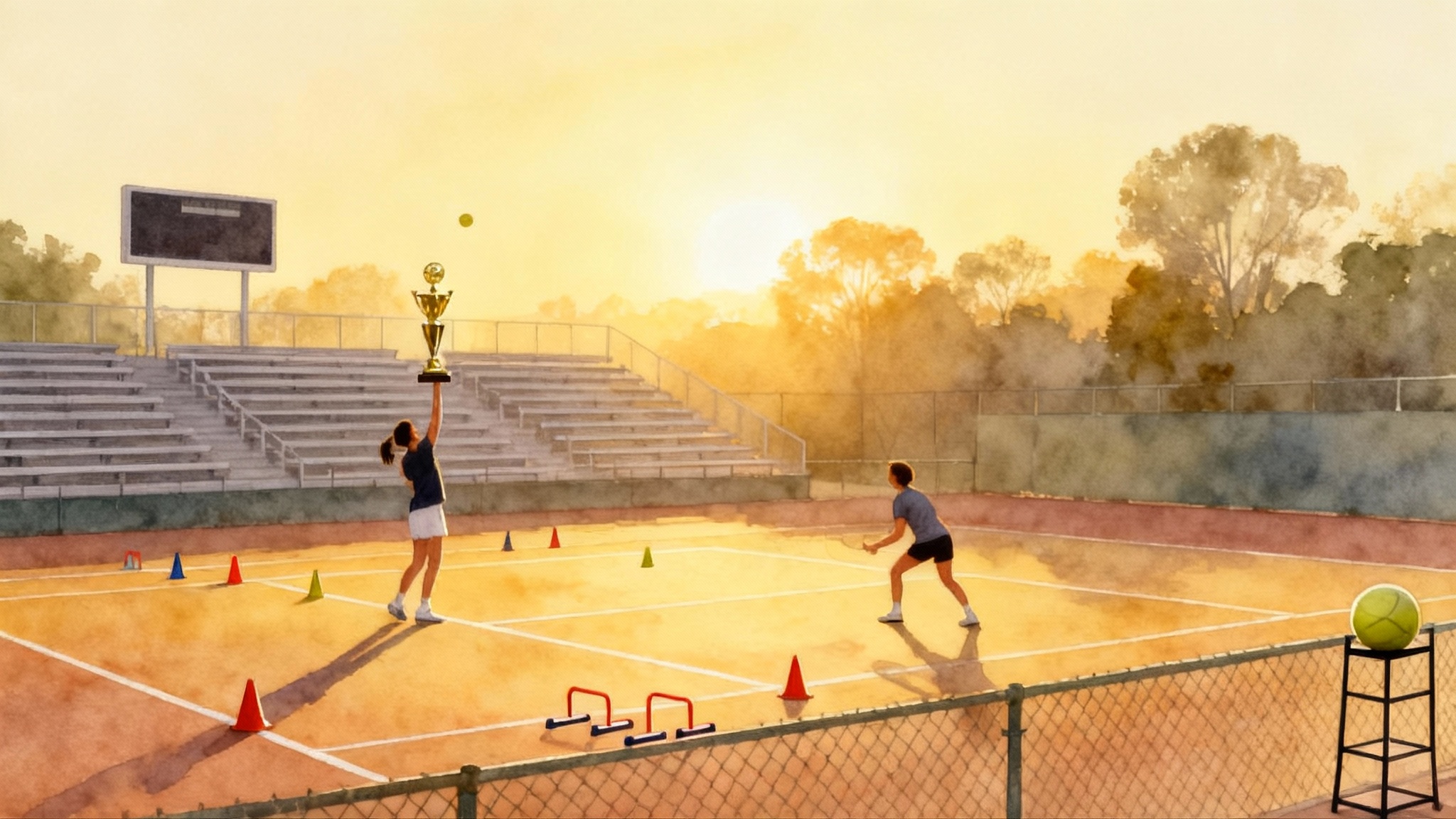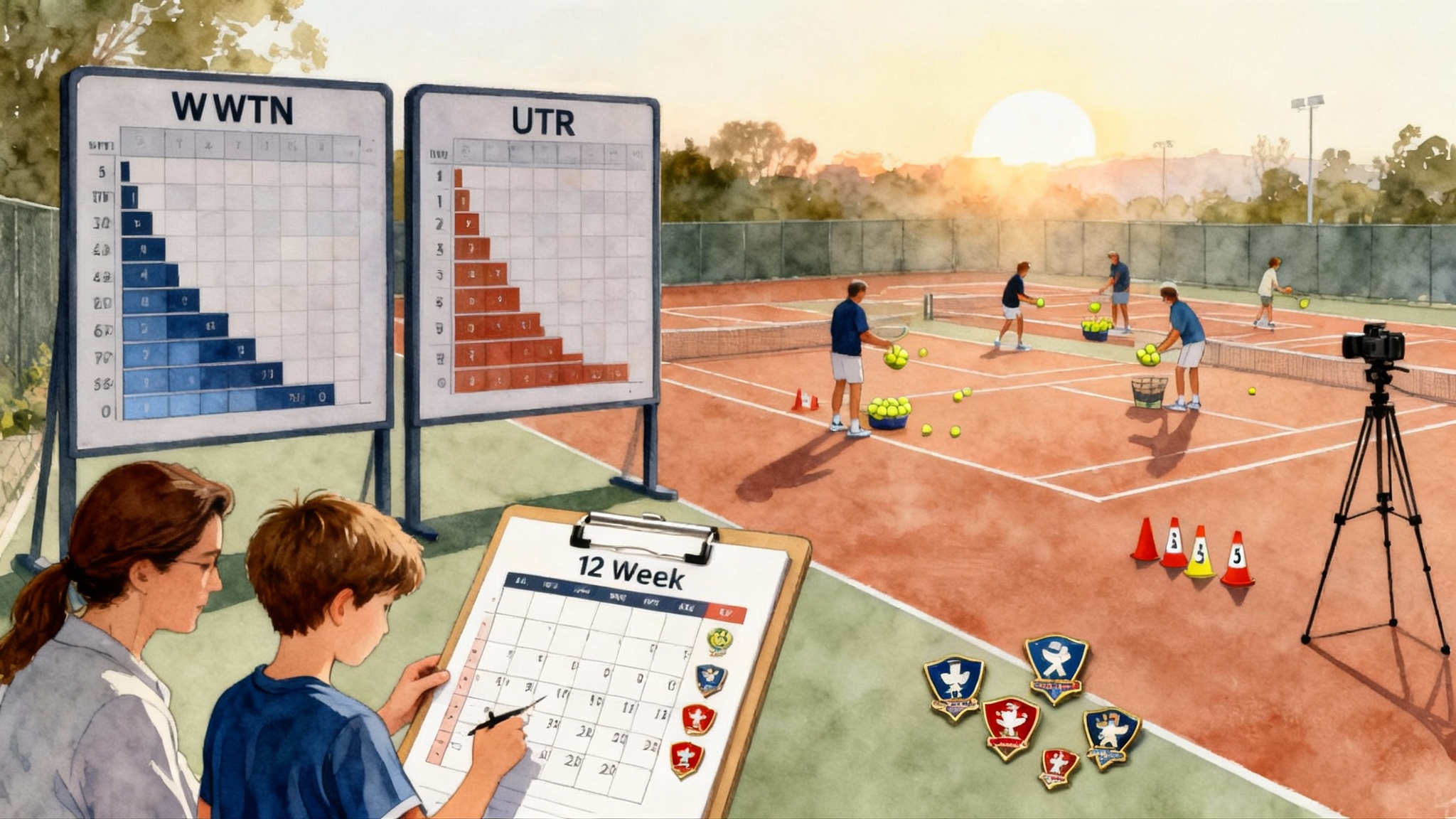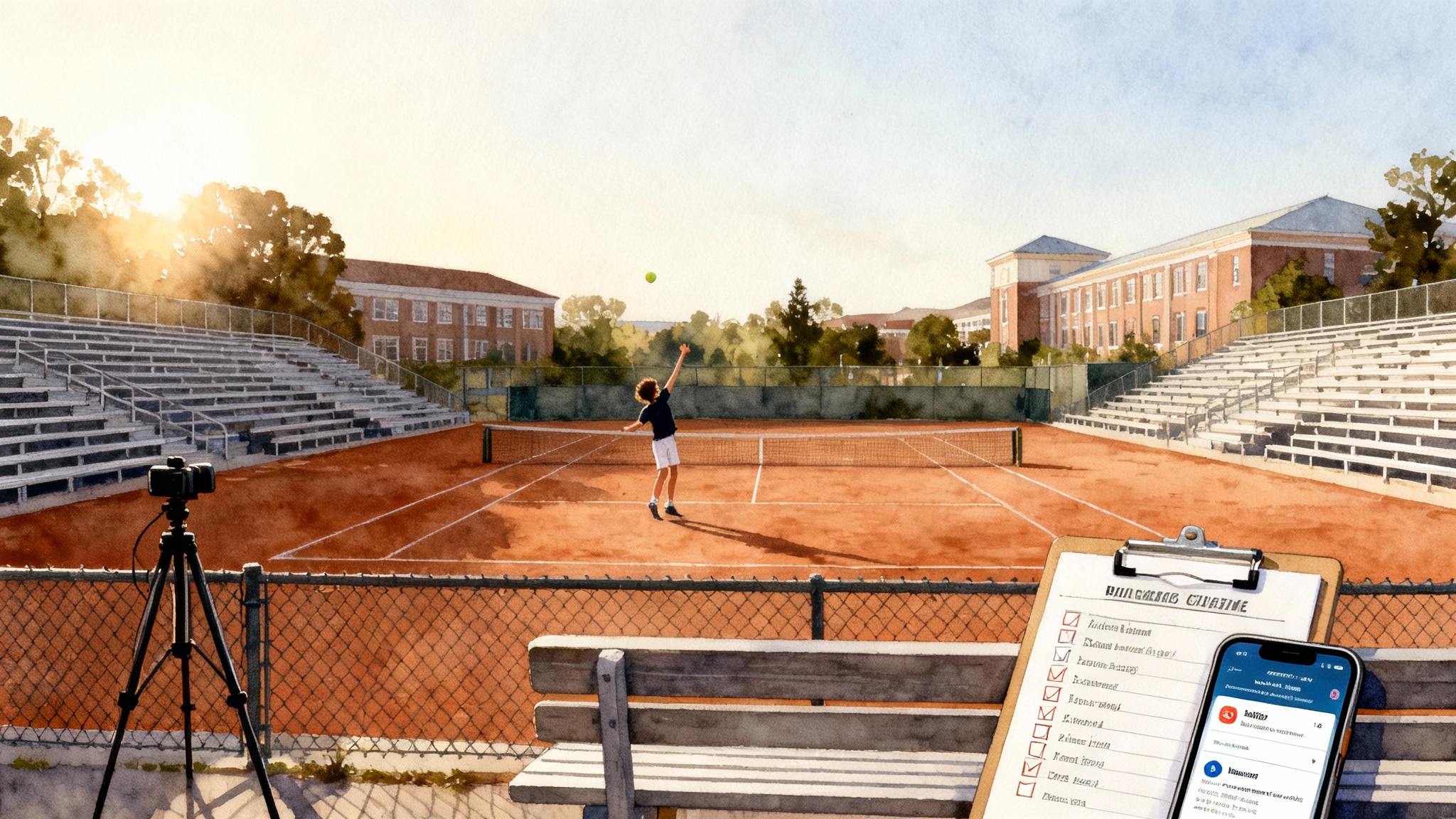Clay-First Tennis: An 8 to 12 Week Plan for U.S. Players
Commit 8 to 12 weeks each year to clay to upgrade movement, point construction, and durability. This plan includes age-specific microcycles, match-to-practice ratios, core clay drills, a court-finding tipsheet, and block scheduling.
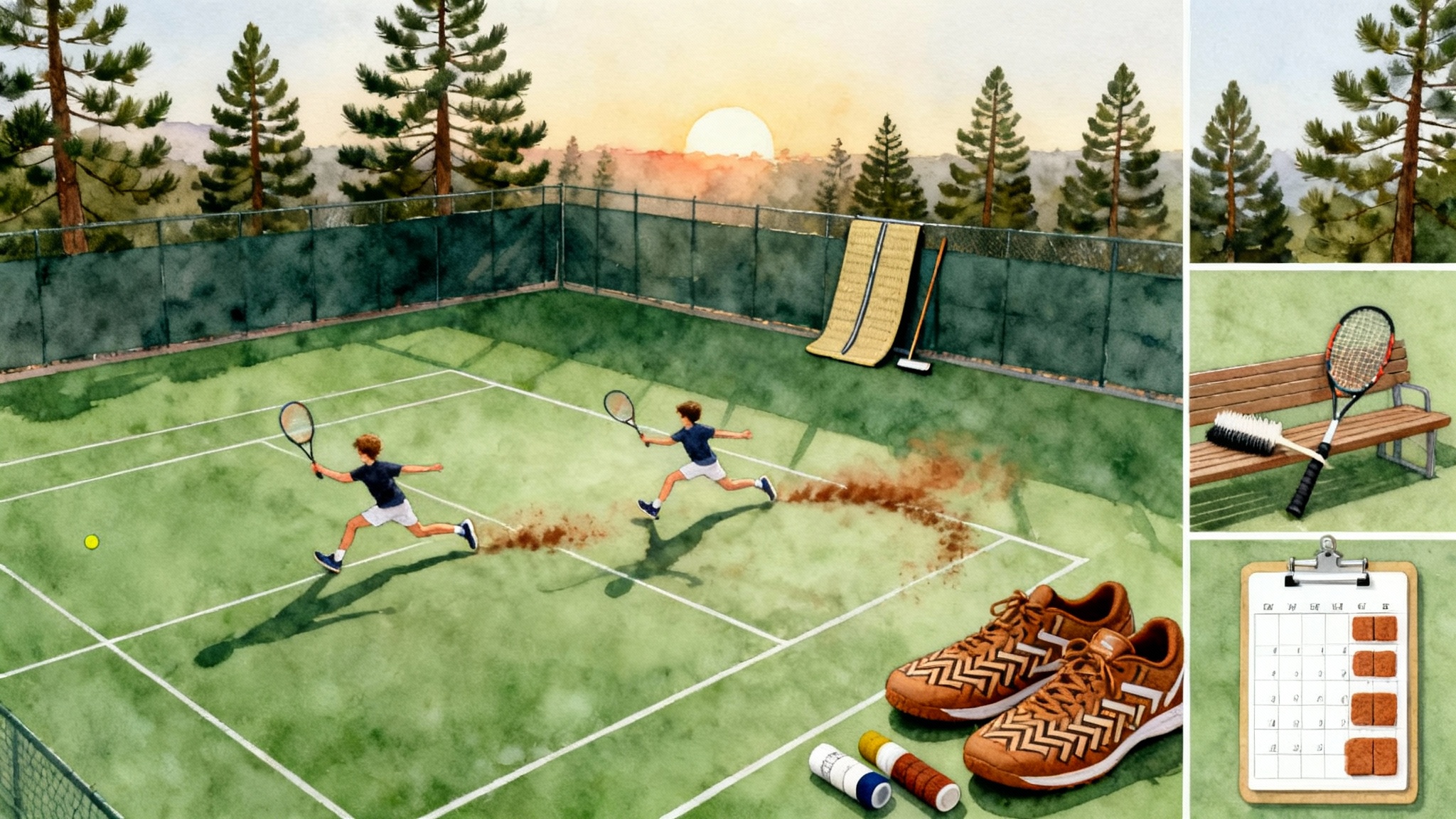
Why 8 to 12 weeks on clay changes a season
Ask any player who grew up on clay and you will hear the same theme. Clay builds efficient movers, smarter point constructors, and bodies that last longer. You do not need to live in Europe or relocate to Florida to get these benefits. Eight to twelve focused weeks each year, run in two or three blocks, is enough to reshape how you train and compete.
Here is why it works:
- Movement efficiency: Clay rewards players who learn to load on the outside leg, slide to decelerate, and recover with balance. The surface gives you feedback every step. If your footwork is late, you skid short and the ball floats. If your timing is right, you carve a controlled slide and plant into the next step. To sharpen the first step and rhythm, review split-step timing made simple.
- Point construction: Longer rallies are common, which forces you to sequence shots. Patterns like two crosscourt to one down the line and the inside out to inside in combo become second nature because you repeat them under pressure.
- Durability: Clay’s softer bite spreads out braking forces compared with typical acrylic hard courts. That helps shins, knees, hips, and backs tolerate load across a season. It will not remove risk, but it helps you practice more without the same pounding.
Think of clay as a movement lab. Over a twelve week span, players can upgrade deceleration, spacing, and height control, then carry those gains onto faster courts. The key is planning blocks with clear goals, not sprinkling in a random clay day.
The clay first season plan at a glance
You want eight to twelve dedicated weeks. Break them into two or three blocks that match your climate and competition calendar.
- Two block option: Four weeks in late winter and four to eight weeks in summer. This fits players in northern states who rely on indoor facilities from January to March, then hit outdoor clay June to August.
- Three block option: Three weeks in early spring, three to four weeks in midsummer, and two to three weeks in early fall. This spreads the learning and gives more chances to apply it in matches.
Example by region without relocating:
- Northeast and Midwest: Use indoor clay or bubbled Har Tru courts in February and March for Block 1. Outdoor clay opens late May. Schedule a June or July Block 2. Add a September mini block while weather holds.
- Southeast: Outdoor clay is common. Run a February or March Block 1, a June Block 2, and an October Block 3 around school and tournament schedules.
- West Coast and Mountain: Seek resort day passes, public park clay, and occasional weekend drives. Block 1 in March, Block 2 in July, Block 3 in September. If clay is scarce, supplement with footwork ladders and sliding drills on turf, then convert at least two sessions per week onto actual clay during each block.
Do not chain clay blocks right before major hard court events. Build them earlier, then taper back onto your usual surface seven to ten days before a big hard court tournament so your timing for lower bounce and faster speed returns.
Age specific microcycles and weekly templates
The goal is to make each week simple to execute. Below are three to four week microcycles for each age band with match to practice ratios and purpose. Adjust volume to your schedule. When in doubt, keep the drill menu tight and repeat. For total weekly load by age, see our weekly tennis plans by age.
10 and under
Purpose: Learn spacing, height, and safe sliding. Use red, orange, or green balls depending on level.
- Weekly plan for a three week block:
- Monday: 60 minutes. Movement school. Split step timing, figure eight cone runs, balance stops. Finish with 15 minutes of cooperative rally targets.
- Wednesday: 60 minutes. Two cross one line pattern with targets. Add drop shot and lob games.
- Friday: 60 minutes. Serve into cones, return into deep zones, four point games to seven.
- Weekend: Friendly set play if available.
- Match to practice ratio: One match day for every three practice days.
- Key cues: Big base, eyes up before contact, soft knees before the slide, recover with small crossover steps.
Ages 11 to 14
Purpose: Build reliable patterns and first slide confidence on both sides.
- Weekly plan for a four week block:
- Monday: 90 minutes. Footwork circuit. Outside foot load and slide, crossover recovery, split timing drills. Finish with rally to the big cross target.
- Tuesday: 60 minutes. Serve plus one pattern with height windows. Add the two cross one line pattern and inside out to inside in.
- Thursday: 90 minutes. Pattern play sets. Start neutral, then play point opens to the backhand, then to the forehand.
- Saturday: One to two short sets or a practice match.
- Match to practice ratio: One match day for every three practice days.
- Progress marker: Land at least six controlled slides per side in a 15 minute drill block without losing balance.
Ages 15 to 18
Purpose: Raise rally tolerance, pressure patterns, and transition skills on slower bounce.
- Weekly plan for a four week block:
- Monday: 120 minutes. Physical day. Build with tempo rallies to 12 balls. Work outside foot decelerations, then add direction change. Finish with heavy cross to short line.
- Wednesday: 90 minutes. Serve plus pattern sets. First ball deep cross, then early change down the line. Approach when height is below net level.
- Friday: 90 minutes. Defense to offense. Dig two heavy balls crosscourt, counter down the line. Add passing neutralization games.
- Saturday or Sunday: Full match play.
- Match to practice ratio: One match day for every two to three practice days depending on tournament load.
- Progress markers: Track unforced errors in long rally games and second serve plus one percentage to a crosscourt deep target.
Adult returners
Purpose: Build durable legs, reliable height, and specific patterns that do not require elite speed.
- Weekly plan for a three week block:
- Tuesday: 75 minutes. Warm up plus height control to deep boxes. Add crosscourt rally ladders to 10 and 20 balls.
- Thursday: 75 minutes. Serve plus one to a big cross. Recover with small steps. Add approach after a short ball.
- Weekend: Doubles first, then a short singles set.
- Match to practice ratio: One match day for every two practice days.
- Progress marker: Fewer than two foot faults over a session, and at least 60 percent of serves landing in a planned target half.
Clay essential drills and footwork patterns
Build a core menu and cycle it every block. Here are twelve reliable choices with how to run them.
- Outside foot load and slide
- Place two cones wide on the baseline. Feed a crosscourt ball. Player plants on the outside foot, glides, and brakes before contact. Recover with a crossover. Three sets of six per side.
- Figure eight recoveries
- Two cones near each singles sideline and two near the center hash. Rally or self feed. Loop in a figure eight and hit five balls while keeping balance through each recovery. Two sets each side.
- Two cross one line pattern
- Rally crosscourt twice, change down the line on ball three. Opponent neutralizes back cross. Repeat. This anchors patience before changing direction.
- Banana forehand to outside corner
- Feed a short ball. Player shapes height and curve around the outside of the ball and lands crosscourt deep. Recover with a crossover. Three sets of eight.
- Defense to offense ladder
- Start two steps behind the baseline. Receive a heavy ball, reset crosscourt, then counter down the line when height drops. Build from three ball to five ball exchanges.
- Serve plus high heavy one
- Hit a serve, then lift a heavy cross to a deep target. If the reply is short, change direction and approach. Track whether you earn a short ball at least 50 percent of the time.
- Backhand squash slide
- On wide defensive balls, practice a one hand squash style block with a controlled slide. The goal is depth and height, not pace. Three sets of six per side.
- Short ball approach decision
- Coach tosses a short feed. Player must call drive, shape, or drop before swinging. If height is net tape or lower, drive. If shoulder height, shape. If opponent is deep and off balance, drop.
- Drop shot to lob rescue
- Player executes a drop shot. Opponent runs it down and replies. Original player must read and either finish or retreat with a lob. Two sets to 11.
- Five ball breaker
- Start with serve, then four rally balls with planned directions. Build rhythm under a count. Miss and you reset to ball one. Great for adults and juniors.
- Line tolerance drill
- Target a strip one foot inside each sideline. Rally crosscourt, but a point only counts if it lands in the target strip. Teaches shape and margin.
- Split timing check
- Toss a ball that lands early or late while a partner intentionally varies contact rhythm. Player must time split to ball bounce. The goal is to start the split when the opponent begins their forward swing.
Match to practice ratios by level
Ratios anchor the block. Use these as a base and adjust for school and travel.
- 10 and under: One match day for every three to four practice days
- Ages 11 to 14: One match day for every three practice days
- Ages 15 to 18: One match day for every two to three practice days
- Adult returners: One match day for every two practice days early in the block, then move toward one to one if legs feel good
When in tournament phases, convert one practice day to a pattern rehearsal and keep the other for movement and feel.
Equipment and surface checklist
Clay rewards small gear choices and simple maintenance.
Player gear:
- Clay specific shoes with a full herringbone outsole for clean release
- Two pairs of moisture wicking socks per session to swap at halftime
- Overgrips and a small towel for sweat management
- String tension two pounds looser than your hard court setup to lift shape and depth
- Hat or visor and a light colored top to reduce heat load
- A nail brush and small plastic bag for clay covered socks and shoes
Coach and organizer kit:
- Line brush and court broom
- Roller or drag mat if you have access to it
- Cones, flat dots, and a small chalk for target boxes
- A court squeegee for post rain clean up
Surface notes:
- Green clay, often called Har Tru, is the most common in the United States. Red clay exists in pockets. Training transfers across both. Green plays a bit faster with a higher bite. Red plays slower with a slightly higher bounce.
- After rain, expect a heavier court and shorter slides. Adjust targets higher and aim deeper by a step.
U.S. clay court finder tipsheet
Finding clay near you is half strategy and half persistence. Use these steps:
- Search terms: Try green clay, Har Tru, clay courts, or sub irrigated clay plus your city or county.
- Call local clubs: Even if their site lists only hard courts, some have one or two clay courts reserved for league play or mornings.
- Ask your United States Tennis Association section office or district about facilities with clay and about league nights that reserve those courts.
- Colleges and high schools: Athletic departments sometimes allow paid community access during summer. Speak with the facility manager early.
- Resorts and public parks: Many resorts offer non member day passes. City parks in older neighborhoods sometimes have clay courts tucked behind baseball fields.
- Bubble season: In colder regions, indoor clay often lives under bubbles from November to March. Ask about non member drop in rates and off peak hours.
- Build a micro network: Two to three families or adult friends who commit to certain mornings can secure recurring court times and reduce costs.
Call script that works: “I am planning a three week clay block and need two 90 minute sessions per week between 7 a.m. and 10 a.m. Do you have clay courts I can book, and what days are most available for that window?” Then ask to reserve the same slots for three or four consecutive weeks.
How to run two or three clay blocks without relocating
You can craft blocks around school, work, and junior tournaments by clustering days and keeping travel tight.
- Anchor mornings or late evenings: Clay plays best when cooler and slightly damp. A 7 to 8:30 a.m. slot avoids mid day heat and increases availability.
- Build a partner pod: Two to four players at similar level keep the rally quality high. Rotate roles, assign a pattern focus, and keep score so pace stays honest.
- Stack sessions: For juniors, try Monday and Wednesday mornings for movement and patterns, then a Saturday match. For adults, use Tuesday and Thursday evenings plus a Sunday match set.
- Use micro camps: If weekday access is hard, run Friday evening plus a Saturday morning double session during your block.
- Bridge back to your main surface: In the last week of a block, add one hard court session for timing, but keep the clay session to preserve feel.
Sample three block calendar that totals eleven weeks:
- Block 1 late winter: Three weeks in February. Two 90 minute sessions and one match day per week.
- Block 2 early summer: Five weeks in June and early July. Two to three sessions plus one match day per week.
- Block 3 early fall: Three weeks in September. Two sessions and one match day per week.
Spotlight: a clay first pathway in practice
In the southeastern United States, programs like the Smith Stearns Tennis Academy in Hilton Head Island have long integrated clay as a training backbone. Their juniors often spend long stretches on green clay, rehearse patient patterns, and sharpen transition instincts on slower bounce. The takeaway for families outside the region is not to copy every detail. It is to notice the rhythm. Movement school early in the week, pattern rehearsals midweek, and competitive sets on the weekend. That rhythm is portable if you reserve courts and build a small training pod.
Turning drills into habits that transfer to hard courts
Clay first is not clay only. The point is carryover. Here is how to lock it in.
- Movement cues on all surfaces: Keep the outside foot load into the ball, then use small crossover recoveries even on hard courts. You may not slide on acrylic, but the rhythm matches.
- Height windows remain: Hitting three to four feet above the net and landing deep is a habit that wins on any surface. Use targets that teach depth, not lines that demand flat shots.
- Serve plus one discipline: Clay will punish lazy first ball decisions. Build the habit to choose a big cross target first, then make the early change when you gain height or time.
A compact checklist to start your next block
- Choose dates for your next three or four week block
- Confirm two practice slots and one match slot per week for the block
- Recruit two to three partners and agree on roles for each day
- Pick four core drills from the list to repeat weekly
- Decide your match to practice ratio and post it where everyone can see it
- Pack your gear and label a court kit that stays in your trunk
- Track one or two progress markers per week, such as rally length or serve plus one depth
Conclusion: the small seasonal habit that compounds
Eight to twelve weeks per year on clay is not a luxury. It is a simple seasonal habit that compounds. You build cleaner movement because the court teaches you how to brake and recover. You build smarter patterns because longer rallies demand them. You build durability because your training load spreads across softer steps. Plan two or three blocks, reserve your slots, and keep the drill menu tight. The gains will follow you onto any court you play.
